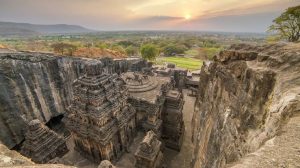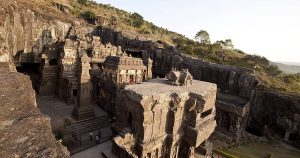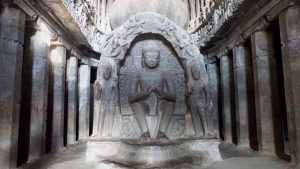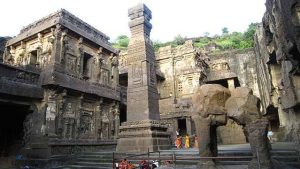Digital News Guru Education Desk:
Ellora Caves: A Marvel of Ancient Indian Architecture and Spirituality
Located in the state of Maharashtra, India, the Ellora Caves are a remarkable ensemble of ancient rock-cut temples, monasteries, and shrines that have captivated historians, archaeologists, and tourists for centuries. These caves are among the most significant historical and architectural wonders in the world, offering a fascinating glimpse into India’s rich cultural and religious heritage.

The Ellora Caves are renowned not only for their sheer scale and grandeur but also for the unique blending of different religious traditions, making them a symbol of India’s spiritual diversity.
Historical Context
The Ellora Caves were created between the 5th and 10th centuries AD, spanning several dynasties and religious movements. These caves were carved into the basalt rock of the Sahyadri mountain range, extending over a 2-kilometer-long stretch. The Ellora site features 34 caves, each with its distinct architectural and artistic style. The caves are divided into three distinct religious sections: Hindu, Buddhist, and Jain, illustrating the coexistence and harmonious development of multiple faiths in ancient India.
The Three Major Religious Groups
One of the most unique aspects of the Ellora Caves is the coexistence of three major Indian religions: Hinduism, Buddhism, and Jainism. The caves provide a testament to the religious pluralism that flourished in ancient India.

Buddhist Caves
The earliest caves at Ellora are the Buddhist caves, which are believed to have been carved between the 5th and 7th centuries AD. These caves were primarily used as monasteries and shrines for Buddhist monks and are distinguished by their serene and simple architecture. The most famous Buddhist cave at Ellora is Cave 10, also known as the Vishvakarma cave, which features a massive, intricately carved Buddha statue. This cave is also notable for its detailed sculptures and inscriptions, which offer insight into the daily lives of Buddhist monks.
Hindu Caves
The Hindu caves, numbering 17, represent a period of flourishing Hinduism from the 7th to 9th centuries. These caves are dedicated to various Hindu gods and goddesses, with elaborate carvings and frescoes adorning their walls. Cave 16, known as Kailasa, is the most significant and awe-inspiring Hindu cave at Ellora. Carved from a single rock, the Kailasa temple is an engineering marvel, featuring intricate sculptures of deities, mythological scenes, and exquisite architectural elements. The grandeur of Kailasa, coupled with its intricacy and size, makes it one of the most famous rock-cut temples in the world.
The temple’s design is said to symbolize Mount Meru, the mythical abode of the gods, and is dedicated to Lord Shiva. The vertical shaft, which leads into the temple’s sanctum, is an extraordinary feat of engineering, showcasing the advanced techniques used by the artisans of the time.
Jain Caves
The Jain caves at Ellora, though fewer in number (five caves), are equally remarkable in their beauty and elegance. These caves were created between the 9th and 10th centuries and are primarily characterized by their clean lines, detailed carvings, and the serene depiction of Jain tirthankaras (spiritual teachers). Cave 32, also known as the Indra Sabha cave, is a standout Jain temple featuring a beautifully carved entrance, a series of ornate pillars, and depictions of Jain cosmology and philosophy.
Jainism, which emphasizes non-violence and spiritual liberation, is reflected in the peaceful and harmonious atmosphere of the Jain caves. These caves were also used as places of meditation and study, where followers could escape from worldly distractions and focus on spiritual practice.

The Kailasa Temple: A Marvel of Engineering
Among the Ellora Caves, the Kailasa temple (Cave 16) stands out as a monumental feat of architecture. Carved from a single, massive rock, the temple is one of the largest monolithic structures in the world. The carving of the Kailasa temple is believed to have taken over 100 years, with thousands of artisans working on it. What makes Kailasa particularly impressive is the fact that the entire structure, including its intricate columns, massive sculptures, and the temple itself, was carved from the top down. The temple features a large courtyard, an elaborate sanctuary, a grand entrance, and stunning carvings that depict scenes from Hindu mythology, including the marriage of Lord Shiva and Parvati.
The temple’s design is believed to represent Mount Meru, the center of the universe in Hindu cosmology, further symbolizing the spiritual aspirations of the creators. The grandeur of the Kailasa temple has earned it a place among the most extraordinary architectural wonders of the ancient world.
Art and Architecture
The Ellora Caves are not just religious sites; they are masterpieces of art and architecture. The carvings and sculptures inside the caves are incredibly detailed, depicting scenes from Hindu, Buddhist, and Jain mythology, as well as daily life in ancient India. The artistic sophistication of the carvings, with their deep symbolism and rich narrative quality, makes the Ellora Caves a treasure trove for art historians and cultural enthusiasts.
The architecture of the caves also reflects the advanced techniques used by ancient Indian craftsmen. The skill required to carve these monumental structures from solid basalt rock—without the use of modern tools or technology—is nothing short of remarkable. The caves are a testament to the ingenuity, artistry, and religious fervor of the people who created them.
Ellora Caves and UNESCO World Heritage Status
In 1983, the Ellora Caves were designated as a UNESCO World Heritage site, recognizing their exceptional cultural and historical significance. The caves are a major tourist attraction, drawing visitors from around the world who come to marvel at their ancient beauty and intricate designs. Despite facing the challenges of weathering and erosion over the centuries, the caves remain a testament to the resilience of ancient Indian art and architecture.

Conclusion
The Ellora Caves stand as an enduring symbol of India’s religious and artistic heritage. Their creation, spanning several centuries and multiple dynasties, reflects the cultural dynamism of ancient India. The unique fusion of Buddhist, Hindu, and Jain traditions within a single site offers a rare window into the spiritual and artistic diversity of the time. Today, the Ellora Caves continue to inspire awe and wonder, serving as a reminder of India’s rich cultural and architectural legacy that has shaped not only the subcontinent but the world.
You May Also Read: Tabu Joins Hollywood’s Dune: Prophecy as Sister Francesca, Returning to Hollywood After 12 Years








